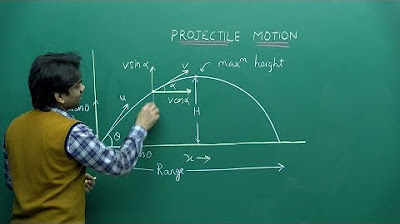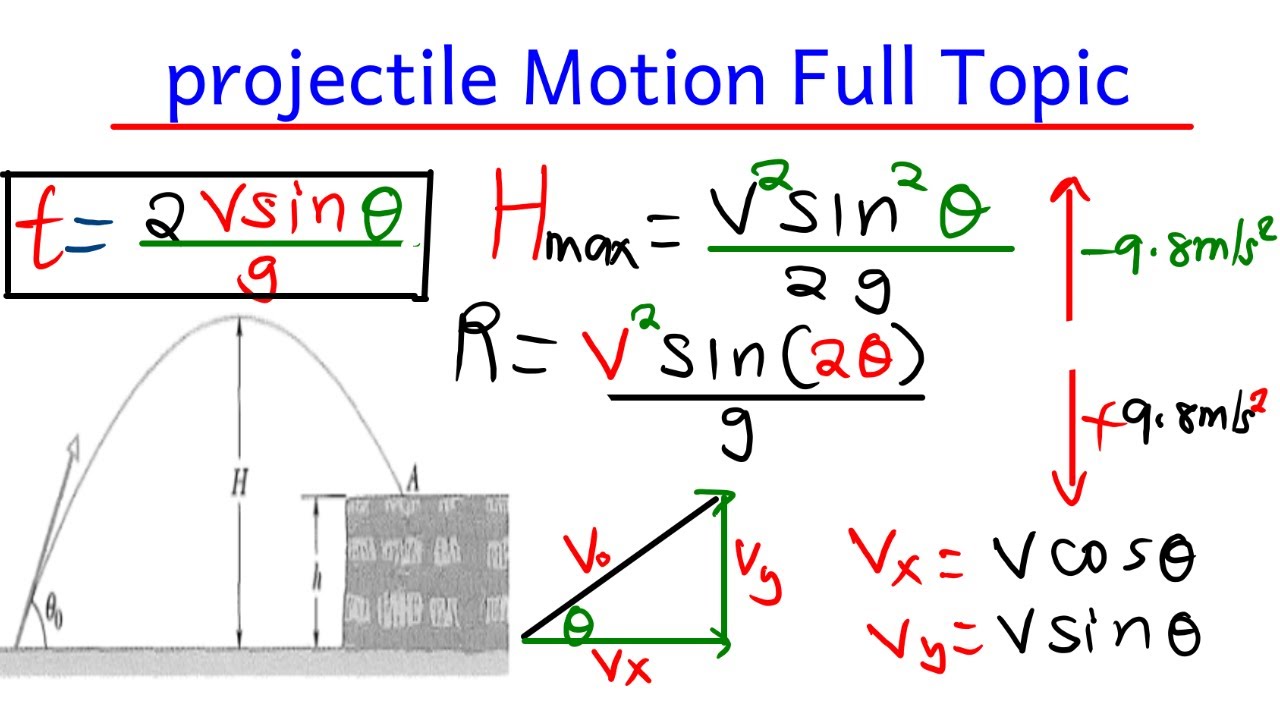Projectile Motion: Finding the Maximum Height and the Range
TLDRThis video script delves into the physics of projectile motion, explaining how to analyze the motion by breaking down the initial velocity into x and y components and considering the constant acceleration due to gravity. The key concepts covered include the independence of x and y motion, the calculation of maximum height and range, and the symmetry of the projectile's path. The script provides mathematical expressions for displacement and velocity in both directions and emphasizes that the maximum height is achieved when the projectile is launched vertically, while the range is maximized at an optimal angle.
Takeaways
- 📐 Projectile motion is analyzed by breaking down the initial velocity into horizontal (x) and vertical (y) components.
- 🚀 The horizontal component of the initial velocity is v0*cos(θ), and the vertical component is v0*sin(θ), where v0 is the initial velocity and θ is the launch angle.
- 🔄 The motion in the x and y directions are independent of each other but linked by time.
- 📉 In the y direction, the only acceleration is due to gravity (g), which is directed downwards with a magnitude of 9.8 m/s².
- 🛤 The horizontal displacement (x) is given by v0*cos(θ)*t, where t is time, and there is no acceleration in the x direction.
- 🏔 The vertical displacement (y) at any time is given by v0*sin(θ)*t - 0.5*g*t².
- 🔄 At the peak of its trajectory, the vertical velocity component is zero, and the horizontal velocity component remains constant.
- 📈 The maximum height (h_max) achieved by the projectile is given by (v0²*sin(2θ))/(2*g), which is maximized when the projectile is launched vertically (θ = 90°).
- 🛤 The range (R) of the projectile, or the horizontal distance traveled, is given by (2*v0²*sin(θ)*cos(θ))/(g), and is maximized when the launch angle is 45°.
- 🕒 The total flight time of the projectile is twice the time it takes to reach the peak height, calculated as 2*(v0*sin(θ))/(g).
- 🔍 Qualitative analysis of projectile motion reveals symmetry about the midpoint of the trajectory, with the velocity vector changing direction vertically and remaining constant horizontally.
Q & A
What is the main topic of the transcript?
-The main topic of the transcript is projectile motion, specifically analyzing the motion of a projectile launched at an angle with respect to the horizontal.
How is the coordinate system defined in the transcript?
-The coordinate system is defined with the positive y direction pointing upwards and the positive x direction pointing to the right.
What are the two components of the initial velocity according to the transcript?
-The two components of the initial velocity are the x-component, which is v0*cos(θ), and the y-component, which is v0*sin(θ), where v0 is the initial velocity and θ is the launch angle.
What is the direction and magnitude of the acceleration during projectile motion?
-The acceleration during projectile motion is always in the y-direction, pointing downwards, with a magnitude of 9.8 m/s², represented as -g.
How is the displacement in the x-direction calculated?
-The displacement in the x-direction is calculated as the initial velocity in the x-direction multiplied by time (Delta X = v0*cos(θ) * time), with no acceleration term since there is no acceleration in the x-direction.
What happens to the y-component of the velocity as time progresses?
-The y-component of the velocity decreases over time due to the acceleration caused by gravity, becoming zero at the peak of the trajectory, and then increases in the opposite direction as the projectile descends.
At what angle will a projectile achieve the maximum height?
-A projectile will achieve the maximum height when launched straight up, which corresponds to an angle of 90 degrees (θ = 90°), where the sine of the angle is equal to 1.
How is the maximum height calculated?
-The maximum height (h_max) is calculated using the formula h_max = (v0² * sin(2θ)) / g, where v0 is the initial velocity, θ is the launch angle, and g is the acceleration due to gravity.
What is the total flight time of the projectile?
-The total flight time of the projectile is twice the time it takes to reach the highest point, calculated as 2 * (v0 * sin(θ)) / g.
How is the range of the projectile determined?
-The range (maximum horizontal displacement) is determined using the formula Range = (2 * v0² * sin(θ) * cos(θ)) / g.
What symmetry exists in projectile motion?
-Projectile motion exhibits symmetry about the vertical line passing through the highest point of the trajectory. This means that the time to reach the highest point is equal to the time to return to the ground, and the path is mirrored across this central line.
Outlines
🚀 Introduction to Projectile Motion
This paragraph introduces the concept of projectile motion, explaining the setup for launching a projectile at an angle with an initial velocity. The speaker defines a coordinate system, with positive y directed upwards and positive x to the right, and emphasizes the independence of motion in the x and y directions due to the influence of gravity. The initial velocity is broken down into x and y components, with the x-component being v0*cos(θ) and the y-component v0*sin(θ). The acceleration due to gravity is described as constant in the y direction with a magnitude of 9.8 m/s², directed downwards.
📈 Equations of Motion for X and Y Directions
The speaker delves into the equations of motion for projectile motion, focusing on the displacement and velocity in both the x and y directions. For the x direction, the displacement is simply the initial velocity in the x direction multiplied by time, with no acceleration affecting it. The velocity in the x direction remains constant throughout the motion. For the y direction, the displacement and velocity are influenced by the acceleration due to gravity. The equations derived describe the projectile's path, including the maximum height reached and the total time of flight, which is twice the time to reach the peak height. The symmetry of the motion around the peak is highlighted.
🎯 Calculating Maximum Height and Range
This section focuses on calculating the maximum height and range of the projectile. The maximum height is found by setting the final y-displacement to zero (at the peak) and solving for the time at which this occurs. The maximum height is derived using the initial velocity and acceleration due to gravity, and it is shown that the highest height is achieved when the projectile is launched vertically (θ = 90°). The range, or horizontal displacement, is calculated by considering the total flight time, which is twice the time to reach the peak. The final expression for the range is given in terms of the initial velocity and the launch angle.
🔍 Summary of Projectile Motion Analysis
The speaker concludes by summarizing the analysis of projectile motion. The initial velocity is broken down into x and y components, with no acceleration in the x direction and constant acceleration in the y direction due to gravity. The equations for displacement and velocity in both directions are reiterated, with the x direction being straightforward due to the lack of acceleration. The y direction's analysis involves the effects of gravity, leading to the calculation of the maximum height and range. The importance of the symmetry around the peak of the projectile's path is emphasized, as it simplifies the calculation of the total flight time and range.
Mindmap
Keywords
💡Projectile Motion
💡Coordinate System
💡Initial Velocity (v-0)
💡Acceleration
💡Displacement
💡Velocity Components
💡Maximum Height
💡Range
💡Symmetry
💡Kinematic Equations
Highlights
Projectile motion is being discussed with a focus on launching a projectile at an angle with respect to the horizontal.
The coordinate system is defined with positive y direction pointing up and positive x direction pointing right.
The motion of the projectile is analyzed along the X and Y directions independently, as they are linked by time.
The initial velocity is broken down into two components: v0*cos(theta) for the X direction and v0*sin(theta) for the Y direction.
Acceleration due to gravity is constant and always directed downwards with a magnitude of 9.8 m/s^2.
Displacement in the X direction is given by the initial velocity in the X direction multiplied by time, as there is no acceleration in the X direction.
Velocity in the X direction remains constant because there is no acceleration in that direction.
Displacement in the Y direction includes an initial velocity term and a term that accounts for the effects of acceleration due to gravity.
Velocity in the Y direction decreases over time due to the acceleration term, and it becomes zero at the peak of the trajectory.
After the peak, the velocity in the Y direction changes sign and increases in magnitude as the projectile descends.
The maximum height achieved by the projectile is given by the formula v0^2*sin(theta)^2/(2*g), with the highest height achieved when theta equals 90 degrees.
The total flight time of the projectile is twice the time it takes to reach the peak height.
The range or horizontal displacement of the projectile is given by the formula 2*v0^2*sin(theta)*cos(theta)/(g).
The motion in the X direction is simple due to the lack of acceleration, while the Y direction requires accounting for acceleration due to gravity.
Symmetry about the top of the trajectory allows for easier calculation of total flight time and maximum range.
The analysis provides equations for displacement and velocity in both X and Y directions as a function of time.
Understanding projectile motion is essential for applications in physics and engineering.
Transcripts
Browse More Related Video

Why Does 45º Launch Angle Give Maximum Range? // HSC Physics

Trajectory of a projectile without drag

Projectile Motion (AP Physics 1)

PROJECTILE MOTION RELATED DERIVATIONS | TIME OF FLIGHT | HORIZONTAL RANGE | MAXIMUM HEIGHT | KANNADA

NEET Physics | Projectile Motion | Theory & Problem-Solving | In English | Misostudy

projectile motion Recorded class
5.0 / 5 (0 votes)
Thanks for rating: